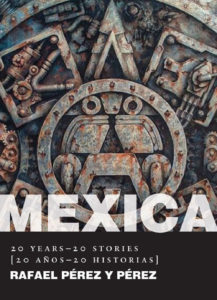Books
The following are books about computational creativity:
MEXICA: 20 YEARS-20 STORIES [20 AÑOS-20 HISTORIAS]
Creatividad Computacional
edited by Rafael Pérez y Pérez (Ed.)
published by Patria/UAM-Cuajimalpa, 2015
ISBN 978-607-744-284-4
Creatividad computacional es el primer libro en su tipo totalmente en español. En sus páginas se aborda esta novedosa y fascinante área del conocimiento, cuyo objetivo es contribuir al entendimiento del proceso creativo mediante el uso de diversos modelos computacionales desarrollados, creados y perfeccionados para el cumplimiento de dicho propósito. En cada uno de los nueve capítulos forma, el lector encuentra interesantes descripciones de sistemas que desarrollan narrativas, construyen y tuitean metáforas o crean nuevos conceptos. Con la firme consigna de evitar en la medida de lo posible, el empleo de un lenguaje técnico, la obra presenta un enfoque interdisciplinario que, sin duda, despertará el interés de todos aquellos estudiosos de las humanidades, las ciencias sociales, el arte y las ciencias de la computación. Todos los autores que contribuyeron con sus textos a la formación de este libro son académicos de gran renombre en universidades de Europa, Estados Unidos y México. Así, la Universidad Autónoma Metropolitana (UAM), unidad Cuajimalpa, y Grupo Editorial Patria ponen a disposición de los lectores hispanoparlantes conocimientos de vanguardia que sin duda ejercen una gran influencia en nuestra sociedad.

Computational Creativity Research: Towards Creative Machines
edited by Tarek Richard Besold, Marco Schorlemmer and Alan Smaill (Eds.)
published by Atlantis Press, 2015
ISBN 978-94-6239-085-0
Computational Creativity, Concept Invention, and General Intelligence in their own right all are flourishing research disciplines producing surprising and captivating results that continuously influence and change our view on where the limits of intelligent machines lie, each day pushing the boundaries a bit further. When taken together and looked at from an integrative perspective, the book in its totality offers a starting point for a (re)integration of Computational Creativity, Concept Invention, and General Intelligence, making visible common lines of work and theoretical underpinnings, and pointing at chances and opportunities arising from the interplay of the three fields.
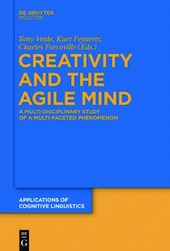
Creativity and the Agile Mind: A Multi-Disciplinary Study of a Multifaceted Phenomenon
edited by Tony Veale, Kurt Feyaerts and Charles Forceville
published by Walter de Gruyter, 2013
ISBN 978-3-11-029529-0
Creativity is a highly-prized quality in almost any domain of human endeavor, whether one is crafting tangible objects from physical materials, or mental objects from concepts, words, pictures and musical notes. It is a diverse, multi-faceted phenomenon that demands a diverse, multi-disciplinary perspective. By bringing together a wide range of creative producers and consumers, in domains as diverse as cognition, language, music, gesture, image and computation, this volume offers the student of creativity a new and exciting perspective whose many facets form a comprehensive and coherent whole.
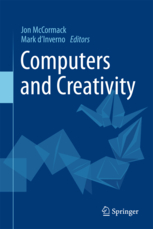
Computers and Creativity
edited by Jon McCormack and Mark d’Inverno
published by Springer, 2012
ISBN 978-3-642-31726-2
This interdisciplinary volume introduces new theories and ideas on creativity from the perspectives of science and art. Featuring contributions from leading researchers, theorists and artists working in artificial intelligence, generative art, creative computing, music composition, and cybernetics, the book examines the relationship between computation and creativity from both analytic and practical perspectives. Each contributor describes innovative new ways creativity can be understood through, and inspired by, computers.

Exploding The Creativity Myth: The Computational Foundations of Linguistic Creativity
by Tony Veale
published by Bloomsbury Acad. & Prof., 2012
ISBN 978-1441181725
Karl Lagerfeld’s description of his sunglasses as a ‘Burqa for my eyes’ drew a huge amount of commentary. But what was going on within that phrase? Why was it deemed original and contentious and what can it tell us about creativity? Taking us through cliche, metaphor, analogy, neologism and surrealism, amongst other creative tropes, Tony Veale offers a comprehensive guide to the actual processes behind linguistic creativity. By grounding his approachable examples in easy to replicate methods, the book is perfect as a resource for individual creative exploration. Anyone with an open mind and a computer and a desire to learn about how we creatively say things with words will love this book.
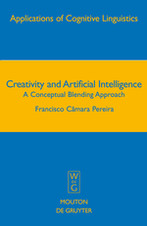
Creativity and Artificial Intelligence: A Conceptual Blending Approach
by Francisco Câmara Pereira
published by Walter de Gruyter, 2007
ISBN 978-3-11-019856-0
Creativity and Artificial Intelligence: A Conceptual Blending Approach takes readers into a computationally plausible model of creativity. Inspired by a thorough analysis of work on creativity from the areas of philosophy, psychology, cognitive science, cognitive linguistics and artificial intelligence, the author deals with the various processes, principles and representations that lie underneath the act of creativity. Focusing on Arthur Koestler’s Bisociations, which eventually lead to Turner and Fauconnier’s conceptual blending framework, the book proposes a theoretical model that considers blends and their emergent structure as a fundamental cognitive mechanism.
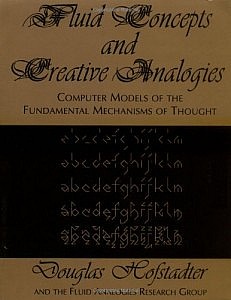
Fluid Concepts And Creative Analogies: Computer Models Of The Fundamental Mechanisms Of Thought
by Douglas R. Hofstadter
published by Basic Books, 1996
ISBN 978-0465024759
Readers of earlier works by Douglas Hofstadter will find this book a natural extension of his style and his ideas about creativity and analogy; in addition, psychologists, philosophers, and artificial-intelligence researchers will find in this elaborate web of ingenious ideas a deep and challenging new view of mind.

Artificial Intelligence and Creativity: An Interdisciplinary Approach
edited by Terry Dartnall
published by Springer, 1994
ISBN 978-0792330615
Creativity is one of the least understood aspects of intelligence and is often seen as `intuitive’ and not susceptible to rational enquiry. Recently, however, there has been a resurgence of interest in the area, principally in artificial intelligence and cognitive science, but also in psychology, philosophy, computer science, logic, mathematics, sociology, and architecture and design. This volume brings this work together and provides an overview of this rapidly developing field. It addresses a range of issues. Can computers be creative? Can they help us to understand human creativity? How can artificial intelligence (AI) enhance human creativity?
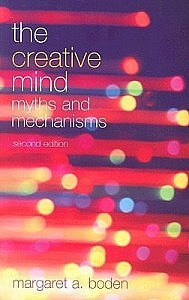
The Creative Mind: Myths and Mechanisms
by Margaret A. Boden
published by Routledge, 1990/2003
ISBN 978-0415314534
How is it possible to think new thoughts? What is creativity and can science explain it? And just how did Coleridge dream up the creatures of The Ancient Mariner? When The Creative Mind: Myths and Mechanisms was first published, Margaret A. Boden’s bold and provocative exploration of creativity broke new ground. Boden uses examples such as jazz improvisation, chess, story writing, physics, and the music of Mozart, together with computing models from the field of artificial intelligence to uncover the nature of human creativity in the arts. The second edition of The Creative Mind has been updated to include recent developments in artificial intelligence, with a new preface, introduction and conclusion by the author. It is an essential work for anyone interested in the creativity of the human mind.



